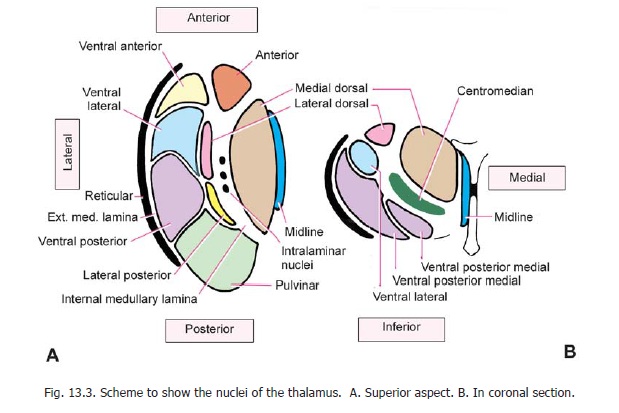Chapter: Human Neuroanatomy(Fundamental and Clinical): The Diencephalon
Internal Structure of the Thalamus

Internal Structure of the Thalamus
The thalamus consists mainly of grey matter. Its superior surface is covered by a thin layer of white matter called the stratum zonale; and its lateral surface by a similar layer called the externalmedullary lamina.
The grey matter of the thalamus is subdivided into three main parts by a Y-shaped sheet of white matter which is called the internal medullary lamina (Fig. 13.3). This lamina is placed vertically. It divides the thalamus into a lateral part, a medial part, and an anterior part situated between the two limbs of the ‘Y’.

A number of nuclei can be distinguished within each of these parts. Only the more important of these are listed below
(a) Nuclei in the anterior part
a. A number of nuclei can be distinguished, but we shall refer to them collectively as the anteriornucleus.
(b) Nuclei in the medial part
a. The largest of these is the medial dorsal nucleus. It is divisible into a magnocellular part (anteromedial) and a parvocellular part (posterolateral).
(c) Nuclei in the lateral part
The nuclei in the lateral part can be subdivided into a ventral group and a lateral group.
The nuclei in the ventral group are as follows (in anteroposterior order).
1. Ventral anterior nucleus.
2. Ventral lateral nucleus (also called the ventral intermediate nucleus).
3. Ventral posterior nucleus, which is further subdivided into a lateral part called theventralposterolateral nucleus, and a medial part called the ventral posteromedial nucleus (Fig. 13.3B).
The nuclei of the lateral group are as follows (in anteroposterior order).
1. Lateral dorsal nucleus (or dorsolateral nucleus).
2. Lateral posterior nucleus.
3. Pulvinar.
(d)Other thalamic nuclei
In addition to the above the thalamus contains the following nuclei.
1. The intralaminar nuclei are embedded within the internal medullary lamina. There are several nuclei in this group. The most important of these is the centromedian nucleus (Fig. 13.3B).
2. The midline nuclei consist of scattered cells that lie between the medial part of the thalamus and the ependyma of the third ventricle. Several nuclei are recognised.
3. The medial and lateral geniculate bodies (traditionally described under metathalamus) are now included as part of the thalamus.
The reticular nucleus, earlier described as part of the dorsal thalamus, is now regarded as part of the ventral thalamus.
Related Topics